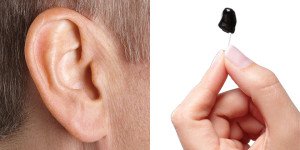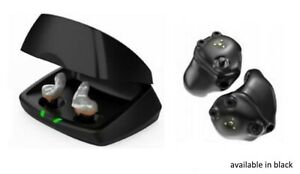Invisible Hearing Aids

Invisible hearing aids, as the name suggests, are not visible to the eye. They are hidden deep in the ear canal and, like most hearing aids, there are a number of styles or variations to these type of hearing aids. They have a variety of names such as ‘invisible-in-the-Canal’ (IIC), contact lenses for the ear, extended wear hearing aids. These are custom made hearing devices, which generally means most types require an impression of your ear is required to fit them. They sit deep down your ear canal so the procedure to take the impression can sometimes be a little uncomfortable, but your Hearing Healthcare Professional (HHP) will take you through the process so you know what to expect.
Invisible hearing aids provide different advantages to other styles of hearing aids, such as:
- The natural resonant frequency of your ear (individual to every person) is preserved as the microphone sits deep in the ear canal.
- You retain your innate localisation abilities due to the positioning of the hearing aid
- The invisibility of the hearing aid – its ‘cosmetic’ appeal – means no one has to know your hearing levels aren’t what they used to be.
Not all ears and hearing levels suit invisible hearing aids so it’s worthwhile to investigate what’s out there and whether an invisible hearing aid would suit you.
The tiny size of these hearing aids means they often miss out on some more advanced features such as Bluetooth connectivity and Rechargeable Batteries.
If you would like more information, please follow one of the links below:
How do invisible hearing aids work?
Technology
Invisible hearing aids sit deep within the ear canal, so the technology that makes them work is very small. Each manufacturer will use their own particular technology but some common factors include:
- Small battery (size 10), that requires changing every 4 – 7 days (except the Lyric hearing aid – read more on this Phonak hearing aid below)
- Removal handle – thin fishing wire to allow for easy removal
- Wireless technology – this is mostly so the hearing aids can ‘talk’ to each other, but some IICs do utilise Bluetooth streaming through accessory devices
Extended wear vs IIC
Extended wear vs IIC
There are a few differences in these types of hearing aids which need to be taken into consideration:
- Fitting procedure – an IIC can be fitted after a custom impression is taken of your ear, (the Signia Pure Nx IIC doesn’t require an impression and can be fitted immediately). An impression of your ear involves placing a foam or cotton block deep in your ear canal and then a putty-like impression material is syringed into your ear canal. It takes a few minutes to set and then is sent off to the manufacturer. An extended wear invisible hearing aid, such as the Lyric, doesn’t require an impression. Instead a thorough inspection of the ear canal with a high magnification device is required to determine where the hearing aid should sit deep and comfortably in the ear canal. As no impression is required of the ear canal, it can be fitted once your ear has been determined as acceptable for a Lyric. Your HHP will then measure your ear canal for the correct Lyric size. Once the exact fit Lyric has been selected it will be inserted by your HHP with the Lyric insertion tool. The hearing aid will then be programmed for your hearing levels.
- Batteries – IIC batteries need to be changed every 4 – 7 days. The Lyric doesn’t need to have the battery changed and can last up to 4 months. At this stage there are no rechargeable invisible hearing aids
- Removal – IIC hearing aids are removed whenever you want to take them out. The Lyric is removed for some medical procedures (MRI) or when it stops working. It needs to be removed for activities such as scuba diving or skydiving. It should be removed if it’s painful. You can remove the Lyric yourself, or get your HHP to remove it, but once it’s out, you need to purchase a new one.
- Cost – the Lyric is sold on a subscription plan, which will cover up to 8 new Lyric devices a year, starting at around $3000 a year. IIC hearing aid costs are per device.
What are the best invisible hearing aids currently available?
Signia:
1 .Silk NX – pricing from $2300
- Ready to wear, instant fit IIC – no impression required
- OVP technology so your own voice sounds natural
- OneMic directionality for improved speech understanding in background noise
- Wireless connectivity so can be controlled with smartphone app (touchControl App) or miniPocket remote
- World’s first CROS CIC – for people with one-sided deafness
- Three technology levels available – not sure what you need? You can try the Demo to find the best level for your hearing loss
Starkey:

- The first discreet device to include both rechargeable batteries and Bluetooth streaming.
- Integrated artificial intelligence and edge mode for amazing sound quality.
- Hands-free phone calls connectivity from your phone, including media streaming from both Android and iPhone devices.
- Available in three technology levels
Phonak:
3. Virto Marvel Black – Prices From $3,600

- Based on the excellent Marvel platform with great sound.
- Can include Bluetooth streaming technology for your Android or iPhone.
- Perfect fit due to technology of Biometric calibration
- Available in three technology levels
- Fully automatic with AutoSense or have the option of control via a smartphone app.
Lyric – yearly subscription pricing
- Extended wear hearing aids – keep in for months at a time
- Wear all day, every day, even when exercising
- Water resistant so you can wear in the shower or participating in water activities where your head isn’t submerged
- Placed in the ear by your HHP trained in fitting Lyric hearing aids
- No batteries to change
- Clear, natural sound
Oticon:
4. OPN IIC – pricing from $3600
- Design features mean more clients can be fitted with this IIC
- Altered faceplate size, reduced length and width of hearing aid means this hearing aid is very small
- Technology uses OpenSound features
- Covers a wider range of hearing loss
Unitron:
5. Insera IIC – pricing from $1500
- Custom made shell
- Using Tempus platform and features
- Can be fitted with a Telecoil
- Comes with an IIC mini remote tool for changing volume and programs
GN ReSound:
6. LiNX-3D IIC – pricing from $3600
- Automatic programming for background noise reduction
- Wind reduction of up to 9dB
- Tinnitus masker program
- Suitable for people with severe high frequency hearing loss with Sound Shaper feature
Are your ears suited to invisible hearing aids?
There are a number of factors to take into account when deciding if invisible hearing aids are suitable for you – they aren’t for everyone. Being small can be cosmetically appealing, but a reduction in size also has some drawbacks. You should look at the pros and cons of invisible hearing aids before deciding if these are the models you wish to try.
Pros
- Discreet – small and basically invisible make these types of hearing aids attractive for those who don’t want to bring attention to their hearing loss
- Powerful for their size – if you have hearing levels up to a moderate or even moderately-severe you can wear an IIC.
- Customised to your ears – these hearing aids are measured to precisely fit your ear canal shape and size. They will fit snugly and hopefully you won’t notice you’re wearing them.
- Bluetooth streaming available in limited models – Starkey IIC hearing aids have Bluetooth streaming. It won’t be long until other hearing aid companies bring out streaming capabilities in their invisible hearing aids.
Cons
- Prone to breakage – this is due to the fact that IICs sit deep in your ears and can get blocked up with earwax and other debris. The biggest issue is when wax gets into either the receiver or microphone. If this happens, your hearing aid won’t work properly and will need to be sent away for repairs
- Repairing your IICs will need to happen at least annually and while they’re being repaired, you won’t have any device to augment your hearing. This can be frustrating for some people.
- The size and shape of your ear canal may make the IIC uncomfortable, or your ear shape be not even be suitable for this type of hearing aid. If you have narrow ear canals, or very small ear canals, it may not be possible to take an adequate impression for a successful fit of an invisible hearing aid. If your ear canal shape is ‘bendy’ or ‘narrow’ or ‘unusual’, the positioning of the microphone for optimal hearing may be difficult and perhaps a different style of hearing aid will be required.
- Invisible hearing aids are not as powerful as the BTE and RIC models. If you have hearing levels greater than in the moderate range, an invisible hearing aid may not be powerful enough to make speech loud enough for you to hear.
- Less features available due to their size. It makes sense that the smaller the hearing aid, not only the less power is available, but also, there is less room to fit in all the features found in BTE and RIC models. It’s important to decide what specific features your lifestyle requires and see if they can be accommodated in an IIC.
- If you suffer from any ear conditions such as dermatitis, otitis externa or fungal infections, these conditions may impact on your ability to wear invisible aids comfortably and/or successfully. Discuss any ear conditions you have with your HHP to see if invisible aids are appropriate for you.
- Other physical factors could limit your ability to successfully wear an IIC. If you have arthritis in your fingers, manipulating the hearing aid correctly in your ear, or changing the batteries could be challenging. The same can be said if you have reduced vision. Orientating the hearing aid correctly or changing the tiny size 10 batteries may be difficult and you may wish to opt for a hearing aid that offers a better solution (such as a rechargeable hearing aid).



